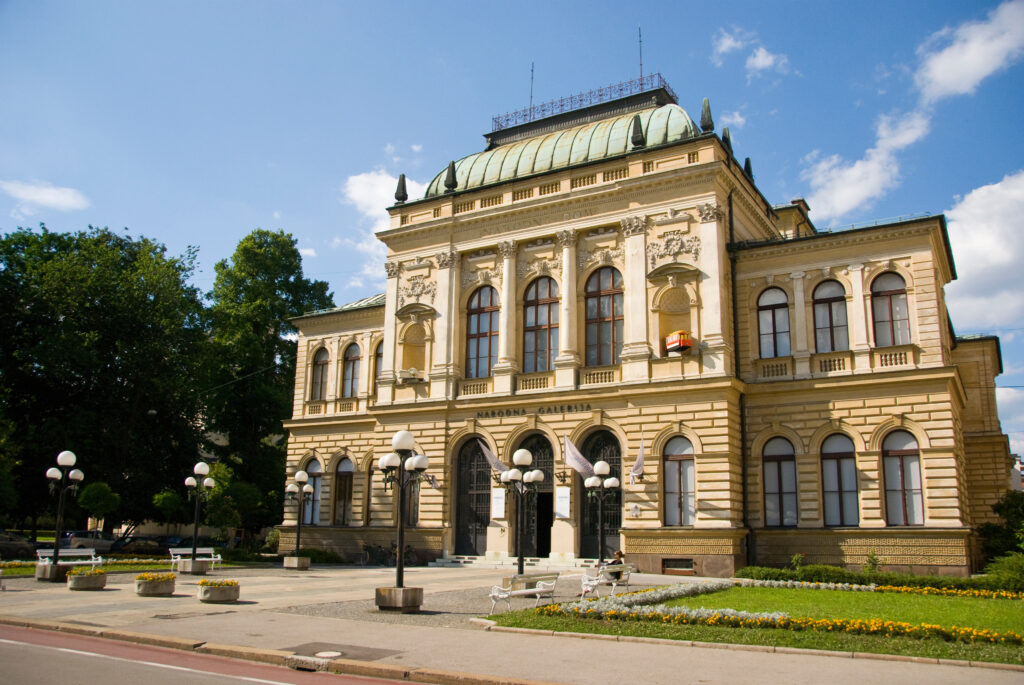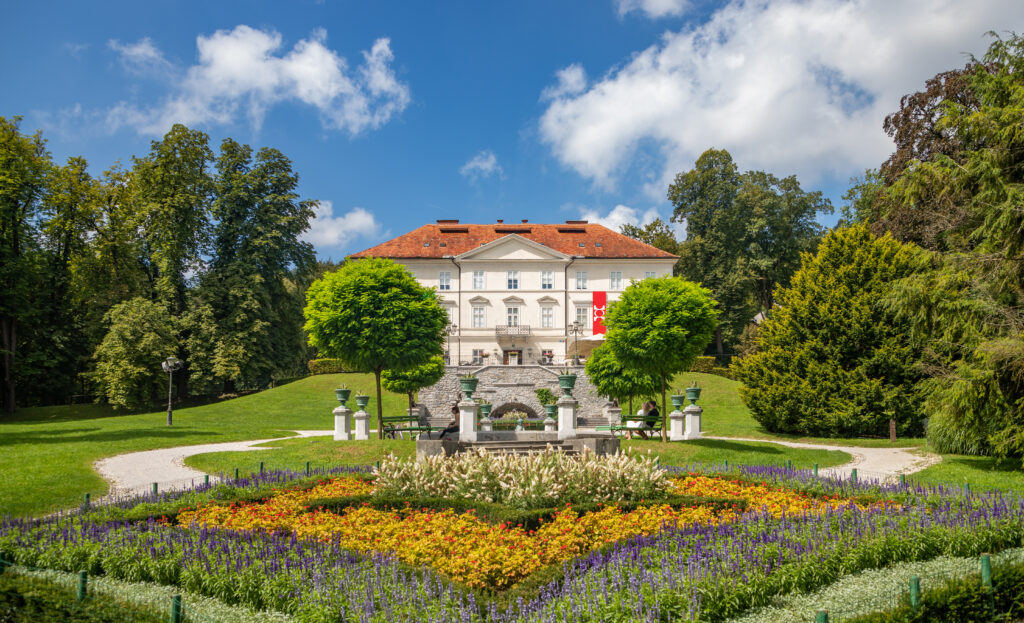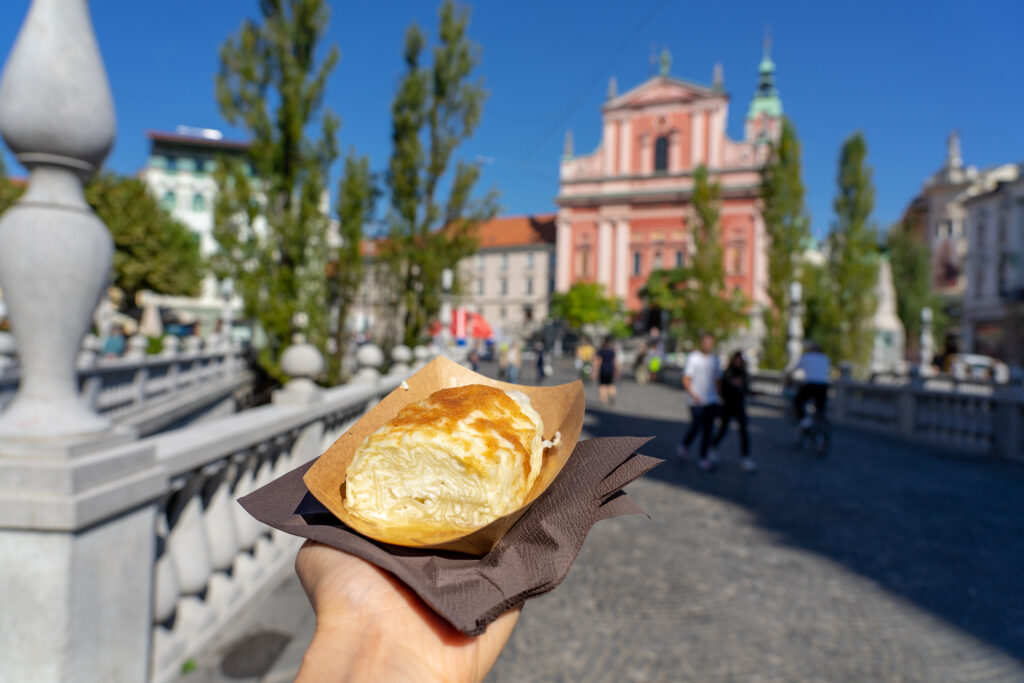
With fewer than 300,000 inhabitants, Ljubljana, nicknamed "the Beloved" in Slovenian, ranks as one of Europe's smallest capitals. Yet the city is not lacking in charm. It has everything you need, without excess: a historic center bordered by the Ljubljanica River, a castle that bears witness to its history, vast green spaces and buildings from the Communist era. The peaceful architecture of the old Baroque quarters and the buildings designed by the famous architect Jože Plečnik give the capital a warm atmosphere. Committed to ecological initiatives, such as the ban on car traffic in the city center, Ljubljana can be discovered on foot or by bike in the heart of a country that is one of our Top 10 greenest destinations to travel to in 2024. Looking to the future and energized by its 60,000 students, Ljubljana attracts visitors with its harmony and quality of life. Let's take a closer look at its must-sees.
1. Ljubljana Castle

Ljubljana Castle towers majestically over the city, and is a must-see when exploring the Slovenian capital in September, for example, whether on foot or by funicular ( book your funicular ticket here ). Although the castle's appearance isn't exceptional, its large inner courtyard is a blend of different architectural styles. But the main attraction is the tower. The 360° panoramic view of Ljubljana is simply breathtaking. You can also watch a 3D projection retracing the history of Ljubljana and the castle. For a more interactive experience, you can opt for the "Time Machine", a six-stage tour corresponding to key periods in the castle's history. Your guide changes costume for each era, taking you from Roman times in the company of a soldier to a meeting with Emperor Frederick III of Habsburg. An entertaining and captivating way to get to grips with the history of this emblematic Ljubljana landmark!
2. The National Gallery of Slovenia

The National Gallery of Slovenia is the country's leading institution dedicated to ancient art. It houses the most extensive collection of Slovenian works, covering a vast period from the early Middle Ages to the 20th century. The first exhibition of its permanent Slovenian art collection took place in 1933 in the Narodni Dom, an 1896 building designed by Czech architect František Škabrout, located at Cankarjeva cesta 20. In 1997, the permanent collection was transferred to a new adjacent building, also known as the Pinacotheca of European Painters. Works are displayed here according to nationality and artistic school, grouping Italian painters, the Spanish school, French, Flemish and Dutch painters, German and Central European painters, as well as artists from the 19th and 20th centuries. Not to be missed during your visit to the Slovenian capital!
3. Prešeren Square

Prešeren Square is a veritable architectural melting pot, combining history and artistic ingenuity. Baroque, Art Nouveau and Secessionist styles, as well as Plečnik's legacy, overlook the waters of the Ljubljanica. Designed by Maks Fabiani, Prešeren Square is graced by two splendid early 20th-century buildings, Ura and Centromerkur. The very essence of the city permeates this space with its magic, while the castle can be admired at a glance. Today, the square is a must for young people and strollers alike. Not to be missed are the monument to Slovenian poet France Prešeren (1800-1849), a veritable national icon, as well as the magnificent Ura building (or Hauptmann house) to the west of the square, the Annunciation church, the neo-Renaissance palace of the Central Pharmacy or Mayer palace (Mayerjeva palača), and of course the Triple Bridge that runs along the south side of the square, linking it to the old town.
4. The Triple Bridge

The central stone Triple Bridge is one of the city's symbols. It was built in 1842 to replace a medieval wooden bridge that had become far too obsolete due to increasing road traffic at the time. Between 1929 and 1931, the eminent Slovenian architect Jože Plečnik made his contribution by designing two adjacent pedestrian bridges, adding a distinctly Venetian touch to the city. In short, a unique architectural signature that today forms an essential part of the Ljubljana landscape. Any traveler passing through the Slovenian capital will be sure to take the time to visit and photograph it.
We recommend that you book this guided tour of the city which takes you to all the must-see places in Ljubljana and includes a funicular ride to Ljubljana Castle.
5. The Municipal Museum

Ljubljana's Municipal Museum stands out as one of Slovenia's most captivating and fascinating museums. It's well worth a visit. Following a major renovation, this magnificent palace offers an immersive experience tracing the capital's history through permanent and temporary exhibitions. In addition to the exhibitions, the museum houses a café and a bookshop. More than just a municipal museum, this establishment adopts an educational and chronological approach, accessible to history buffs of all ages. The basement showcases the Roman remains of ancient Emona, while the rooms on the second floor are arranged chronologically, highlighting Ljubljana's rise as a cultural and intellectual capital of Central Europe. Finally, the educational activities for young visitors are particularly successful.
If you'd like to make several visits, we recommend buying the Ljubljana Card here: it gives you free access to Ljubljana's main museums and galleries, as well as a guided tour of the city, a boat cruise, bike hire and a funicular ticket to Ljubljana Castle.
6. Tivoli Park

Ljubljana's largest city park, first conceived in 1813 under the direction of French engineer Jean Blanchard, has grown over the years to cover almost 5 km2. Today, Tivoli Park is divided into three sections by wide avenues lined with majestic chestnut trees. Dotted with paths, carefully tended flowerbeds, magnificent trees, numerous sculptures, fountains and a fitness trail equipped for outdoor exercise, this is an ideal place to relax just a few hundred meters from the city center. The panoramic view from the top of Rožnik, with its memorial to Ivan Cankar, is simply breathtaking. Get your cameras ready!
7. The Town Hall

The façade of this building represents a jewel of the Slovenian capital's late Baroque style. Built by Gregor Maček, famous for his cathedral dome, theTown Hall (1717-1728) was constructed from two former houses. In the 16th and 17th centuries, it was used as a theatrical venue. Today, the Town Hall hosts art exhibitions, the fruit of international and inter-city collaborations, presenting works by both established artists and amateurs, solo or in groups.
8. Zmajski most, the Dragon Bridge

Where can you find the famous dragon, the iconic Ljubljana landmark that's omnipresent on every souvenir on sale? The obvious place is on the Zmajski most, the famous Dragon Bridge, one of the first on the continent to be built in reinforced concrete. The dragons adorning the bridge were designed by Jurij Zaninovič, a disciple of Viennese architect Otto Wagner (1841-1918), who was Plečnik's mentor. Initially symbols of terror, dragons gradually evolved into the city's protectors, embodying power, courage and wisdom. They also feature on the city's coat of arms.
Would you like to discover the city in an authentic way? We recommend you book this private tour with a local who is passionate about his city and eager to share all his good tips!
9. The House of Jože Plečnik

The House of Jože Plečnik is in fact a museum of architecture, which opened its doors in the 1970s. It is the fruit of a valuable bequest to the city by a descendant of the architect Plečnik, famous for having designed the Triple Bridge, among other things. A stroll through the capital's Trnovo district and a visit to the museum are a must, offering a unique opportunity to immerse yourself in the world of this great architect. Here you'll find an impressive collection of models representing his innovative projects not only in Ljubljana, but also in Belgrade, Vienna and Prague. His studio is also brimming with little treasures to be discovered before setting off to explore a district where he designed the Trnovo Bridge.
10. St. Nicholas Cathedral

First mentioned in 1262, the present-day cathedral has suffered the vicissitudes of history, with several Ottoman assaults destroying it. It was finally completed in the early 18th century under the direction of architect Andrea Pozzo. Recognizable by its dome tinted in shades of green and its two symmetrical towers, it conceals many treasures to be discovered. These include the angels and altar in the transept by Baroque master Francesco Robba, and the magnificent frescoes by Giulio Quaglio. Plečnik, meanwhile, is the author of the bishop's throne. The 19th-century dome was painted by Matevž Langus.
11. The Railway Museum

The Railway Museum offers a unique visit and a fascinating insight into the turbulent past of the Slovenian railroads. The whole family will enjoy the visit! Children in particular will be delighted to climb aboard the old locomotives and explore the old machines and tools. Although the permanent exhibition is informative, it could do with a little more documentation. Finally, it's relatively striking to note that Slovenia was much more involved in the railway world at the beginning of the 20th century than it is today. A must-see!
12. Turkaj Castle

Just 25 minutes from the Slovenian capital, you can make a detour to Turkaj Castle. Damaged by the earthquake of 1511, this castle houses a Lutheran chapel where Jurij Dalmatin, famous for translating the first Slovenian Bible, preached. In 1575, Herbert von Auersperg lost his life in the battle of Budačko against the Turks. Beheaded, his skull was bought back by the inhabitants of Turjak, who paid a considerable sum for it. With this money, the Turks built a mosque in Bosnia. Until 1943, the head was kept as a relic in the castle. A visit to the castle is also an opportunity to take a bike ride through the Slovenian countryside.
13. The House of Illusions

The House of Illusions is a truly unusual museum. Its attractions are well worth the detour, including the famous Vortex, a passageway where illusion literally makes your head spin, and the Upside Down Room, an upside-down chamber where visitors literally lose their footing. This whimsical universe is sure to appeal to young audiences. Of course, to immortalize your visit on social networks, the Maison des Illusions has thought of everything, and selfie poles are judiciously placed in each room. Don't forget your cell phone, and take advantage of our partner's special rates by booking your ticket to the Maison des Illusions here .
14. Shopping

The best places to find gifts to bring back from the capital are on the right-hand side of the bridge leading to the market, in the historic Old Town district. Whether along the river or, even better, in the little street running parallel to the Ljubljanica, from Metodov trg to Vodnikov trg, you'll find a multitude of craftsmen's and designers' boutiques offering their creations at reasonable prices for fine quality items, from decoration to clothing, souvenirs and local gastronomic products. Ljubljana's shopkeepers are passionate about showcasing their region's products and promoting "Made in Slovenia". This approach is often accompanied by a particular sensitivity to the sustainability of consumer goods.
15. Try Slovenian cuisine

Situated at the crossroads of Italian, Austrian, Hungarian and Croatian cultures, Slovenia, with its blend of green paradise and high-quality gastronomy, benefits from the culinary characteristics of its neighbors. Unlike Croatia, whose cuisine is divided between Slavic influences to the east and Mediterranean to the west, Slovenia is essentially a robust gastronomy, blending Germanic and Slavic flavors, dominated by potatoes, cabbage, cereals, smoked meat and dairy products, with a multitude of hearty peasant-inspired dishes. Although Italian notes can be found along the Adriatic coast, renowned for its quality charcuterie and cheeses, Austro-Hungarian influences, of which Slovenia was a part for several centuries, are most evident in desserts, with the unmissable strudel, called zavitek in Slovenian, taking pride of place on every table.
Discover the city of Ljubljana and learn more about Slovenian culinary traditions by booking this guided tour , which will introduce you to a variety of traditional dishes from all over the country.
Where to stay in Ljubljana?
The best place to stay is, of course, in the city center, the historic heart of the capital. Other good places to stay are Krakovo, a small village within the city, or the underground district of Meltekova, with its wealth of bars and restaurants. good options after following our tips for a van road trip to Slovenia.
- Best located:HOTEL IN BISTRO ČAD
Nestled on the edge of Tivoli Park, the Hotel Čad boasts a natural setting right in the heart of the city! This brand-new boutique hotel is a design nugget that you can book right here.
- The most charming:ANTIQ PALACE HOTEL & SPA
Part of Europe's collection of historic hotels, this kind of accommodation is unique in Ljubljana for its character. It's a former noble residence dating back to the 16th century, and you can book it here.
- The most luxurious:INTERCONTINENTAL LJ
The Intercontinental is Ljubljana's first 5-star hotel. The rooms are luxurious, uncluttered and stylishly designed. The spa and swimming pool overlooking the city will convince even the most indecisive: book your stayhere in just a few clicks!
What to see in Ljubljana in 3 days?
Day 1: Reshaped in the early 20th century by the famous architect Joze Plečnik, Ljubljana is a capital city on a human scale. To make the most of its many assets, two days are not too much time to explore the old historic center. We'll start by focusing on the east bank of the Ljubjanica, with the Dragon Bridge, the lively market square, St. Nicholas Cathedral, the Seminary Palace with its library and frescoes, the castle, the old street of Stari Trg and St. John's Church.
Day 2. The second day spent in the capital, this time on the west side of the Ljubljanica, will allow you to stroll along the riverbanks and along the famous Triple Bridge built by Joze Plečnik, then discover the architect's birthplace, the Church of the Virgin Mary of Good Help, the Franciscan Church of the Annunciation, as well as Copova Street, which leads to the Opera House, the National Museum and the Gallery of Modern Art.
Day 3. The third day can be devoted to an excursion outside the city, such as to Turkaj Castle, 25 minutes from the capital, or to the splendid Lake Bled, 1h30 away, which is one of our 15 most beautiful places to visit in Slovenia and one of our 15 most beautiful villages in Europe.
Find out more about the trendiest things to do in Ljubljana below:


